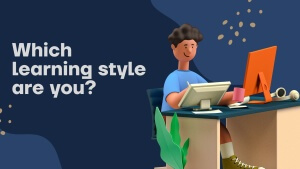Learning Styles: Variety Matters
By: Daniela Reeve Published:It is no secret that everyone learns differently. You may not know, however, that there are defined types of learning styles. Each has a very different way of functioning, specific to the individual.

According to the VARK system, there are four types of learning styles: Visual, Aural, Read/Write, and Kinesthetic. Here we will explore each style and learn which of Speechpad’s offerings can best help you!
Visual Learning
Characteristics of a Visual Learner
Visual learners prefer information depicted through things like diagrams, charts, symbols, patterns, and designs rather than words. Think of your graphs, arrows, and other symbols that could be used to represent what is not spoken. This is different than learning through taking notes or simply looking at pictures or watching a movie. Visual learners work best when information can be relayed and conveyed via a flow of material presented in a way other than words.
Accommodating Visual Learners
If you feel like this might be you, consider having a marker and whiteboard handy during meetings, lectures, etc. Allow yourself to doodle about what you’re hearing or discussing. This is where your creative juices, so to speak, will flow well. If you’re a teacher, consider handouts for your students where they can draw diagrams next to the written word. Supervisors and department heads may find that they can do the same with transcribed meetings and webinars.
Try Speechpad’s Record-A-Call Feature Now!
Auditory (Aural) Learning
Characteristics of an auditory learner
When you show a preference for auditory learning, you work best by listening to the spoken word. You thrive at lectures or in large discussions. You can process and absorb information simply by listening. You enjoy talking on the phone. You don’t mind speaking up in class or reading out loud.
Accommodating auditory learners
Allow these learners the time and space to verbally work through a problem. Perhaps they’ll simply need to read a text aloud or hear something repeated a few more times. Other learners may need to talk through a problem and brainstorm out loud to get the most out of their ideas.
Reading/Writing Learning
Characteristics of a reading/writing learner
Do you make lists, have a diary, or love journaling? Does your hand hurt from feverishly taking notes during lectures? Do you find yourself losing track of time while you read? Have you consulted the dictionary or Google only to find yourself happily going down a wormhole of information? If any of these apply to you, you’re probably a reading/writing learner.
Accommodating a reading/writing learner
Those that learn best from reading and writing excel at note taking, and text based information is preferred. These learners may take a bit of extra time simply because note taking can be time consuming.

Try transcripts for any lectures, meetings and discussions so the learner can review the information on their own time. Transcription also allows for the learner to print out material and record notes to fortify understanding. If you use webinars for professional development, marketing efforts, or for your students, consider having them captioned to allow the user to read along with what is being said.
Kinesthetic Learning
Characteristics of a kinesthetic learner
The kinesthetic learner needs real-world experiences and examples to succeed. These learners are very involved in trying things out to better understand what is being taught. They may need to act out the information to process it, and might jump at the chance to touch, hold, or manipulate what is being discussed.
Accommodating a kinesthetic learner
Encourage your kinesthetic learners to act out scenarios, dive in and manipulate objects if possible, or perhaps create a game based on real-world experiences and information.
Be Mindful
While there may be defined learning styles, no one fits perfectly into one box. Keep in mind that some, regardless of what learning styles you lean toward, simply take more time than others to process and absorb information. Your employees or students will appreciate the time and consideration you’ve taken to understand the different needs and abilities of everyone. If you’re unsure which of Speechpad’s offerings work best for you or your learner, we can help you get started now!